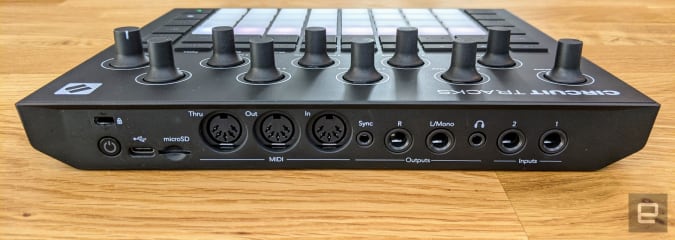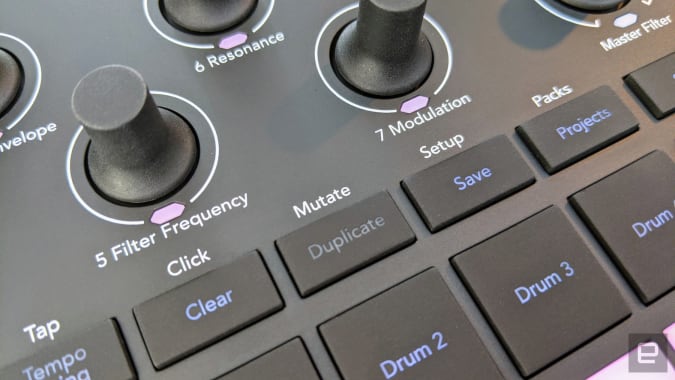[ad_1]
Novation’s Circuit groovebox is a pretty beloved piece of entry-level music making gear. And with good reason. Its two polyphonic synth tracks and four sample-based drum tracks give it a surprising amount of flexibility for something that’s only $329. But, it’s also getting a little long in the tooth. That’s not to say it’s lost any of its charm — and Novation has done an excellent job in providing frequent feature updates. But the world of budget-friendly grooveboxes has exploded since its debut in 2015. The Circuit Tracks is a direct descendant of the original. It takes basically the same core feature set, adds some much requested features and sticks it in a slightly more friendly box.
The heart of Circuit Tracks is still two polyphonic synth tracks, based on its Nova engine, and four sample-based drum tracks. The general layout is also the same, with a grid of 32 velocity sensitive pads at the bottom, framed by a bunch of buttons for controlling its various features, and 10 knobs up top. The knobs are all labeled this time though, as are all the shift functions which should make navigating the interface a bit easier. The one issue is that the labels are all specifically for the synths, and don’t really apply to the drum tracks or other parts of the workflow.
That being said, it’s not that hard to figure out what’s going on. The indicator LED under the knobs light up to match the color of the various tracks in mixer mode so you know which controls what. And they’re all actually aligned with the different tracks vertically, so when you’re tweaking the FX levels, you know that knob five (filter frequency) is controlling the send for Drum 1.
It will still help to have the manual handy though, as you start exploring some of the Circuit Tracks’ more advanced features like the sync rate and play order in the Pattern Settings or note ties in the Micro Step view.
Having never touched an original Circuit, I can’t say whether or not the Tracks is an upgrade in the build-quality department. But I can say for certain it looks a lot better. The original was boxy with sort of cheap looking blue plastic accents and odd round buttons along the edges that looked very out of place. The Tracks is much cleaner and sleeker. And this is despite trading TRS mini jack MIDI for full-sized five-pin MIDI DIN ports and adding a rechargeable battery (rated for four hours0. The Tracks does sacrifice the built in speaker, though, which is a bit of a bummer. The built-in speakers on portable synths almost always sound like trash, but they’re nice for impromptu jams around the house. It also moves the 3.5mm headphone jack around the back, instead of leaving in on the front where it’s arguably much more useful.

Terrence O’Brien / Engadget
The hardware itself is quite nice. It definitely feels worthy of its new $400 price tag. The body is plastic, but it has a nice matte, soft touch texture. The buttons all are firm and have a nice amount of travel and the endless encoders have a surprising amount of resistance. They even respond differently based on how quickly you turn them, which actually makes them useful for live-performance (something endless encoders are usually pretty terrible for). My one complaint is that they might be a tad too sensitive, especially for delicate tasks like setting levels on the mixer.
The pads are… okay. They’re better than what you’d find on competing budget grooveboxes like the Model:Samples. But they’re definitely nowhere near as good as what you’d find on Akai’s MPC, MPD or MPK lines. You can do some light finger drumming on them, but they’re definitely better for just entering in your sequences step by step.
Terrence O’Brien / Engadget
The primary sequencing features haven’t changed much. There’s a 32-step sequencer with eight patterns per track that you can chain together in various “scenes” to create full songs. You can add “Micro Steps” to strum chords or play hi hat rolls, or nudge things off the grid. You can also, always record live and unquantized to get the feeling of a real performance. And the scale mode makes it easy to stay in key no matter what. And the drum tracks have what Novation calls “Sample Flip”, and Elektron calls sample locking — basically each step can have a different sample. So you can make the most of your patterns by combining, say your bass and snare on a single track.
The more interesting features are borrowed from Novation’s Launchpad line of controllers and sequencers. Individual patterns can also be set to playback faster or slower than other parts of the song and can even have their play order changed. So you can create a synth line that plays forwards and backwards, or even just punch in a bunch of notes in a scale and have the sequence play randomly. Probability and Mutate, also allow you to create sort of controlled chaos. Probability sets the chance that any individual note will play, while Mutate “intelligently” remixes your sequence to create a new one. Mutate is a great way to generate new parts of a track when you’re feeling a little light on ideas.

Terrence O’Brien / Engadget
One of the biggest additions though, is the pair of dedicated MIDI tracks and audio inputs. The simplicity of the Circuit’s sequencing features made it popular as the nerve center of small and affordable synth rigs. But the addition of two sequencer tracks dedicated exclusively to controlling external gear makes it even more viable as the brains of your music making setup. The inputs allow you to then route those external instruments through the Circuit Tracks’ delay, reverb, side chain and compression effects to help glue everything together.
The reverb and delay aren’t anything fancy but, I kind of love them. They have a very lofi digital vibe to them that sounds like it would be perfect for a mid-90s industrial record. The built-in synth and drums sounds are a bit of a mixed bag, however. The drums are samples and, once Novation’s Components app is updated to support Tracks, you’ll be able to make the drums whatever you want. The basic pad and bass patches that come with the tracks are solid enough. But some of the keys and leads left me wanting. Of course, again, when Components is updated you’ll be able to load packs of synth sounds and design your own. It’s just that the out of the box sound selection can be a bit underwhelming.

Terrence O’Brien / Engadget
I’ve only had a few days with the Circuit Tracks, so I’m reserving full judgement. But in my short time with it I’ve been pretty impressed. And am starting to understand why people love the Circuit so much. The Tracks faces stiff competition, though. Elektron’s Model lineup is $100 cheaper, and I think has a slightly more powerful sequencer. Though, they have their own limitations when it comes to sound design. Something like the Polyend Tracker offers a similar ability to take a track from musical nugget to polished track and has far more sample manipulation tools. But, it’s workflow is also more cumbersome and the price is higher at $599.
If you have an OG Circuit, chances are you will love the Circuit Tracks. If you’ve been groovebox curious, this should almost certainly be on your list of candidates.
The Circuit Tracks is available now for $400.
Update: This story originally stated the Circuit Tracks would be available on February 12th, however it is shipping now.
[ad_2]
Source link